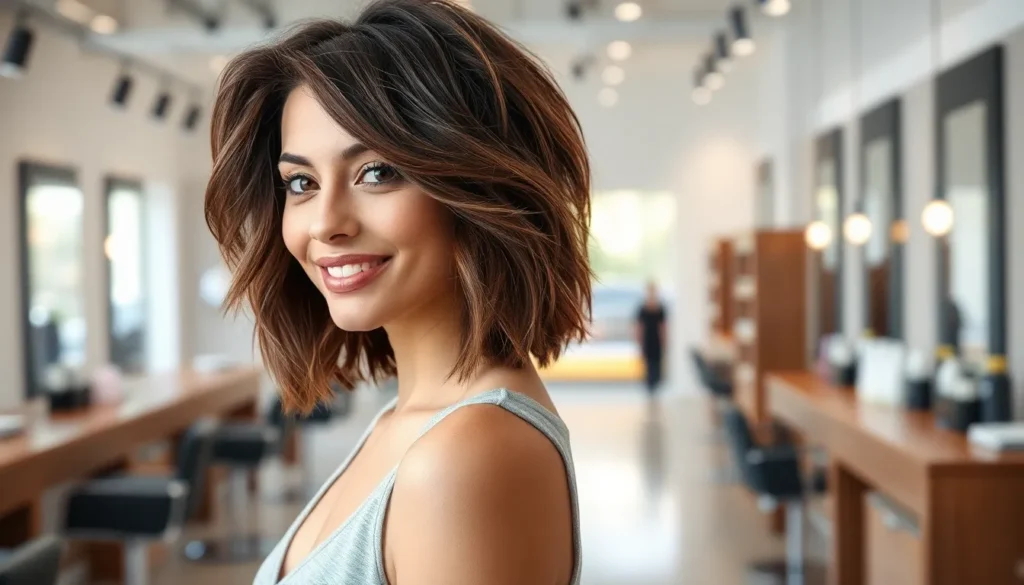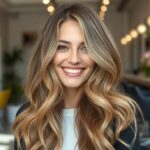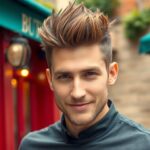The textured bob has taken the hair industry by storm and we can’t get enough of this effortlessly chic style. This modern twist on the classic bob combines strategic layering with subtle texture to create movement that’s both sophisticated and playful. Whether you’re looking to refresh your current look or make a bold style statement the textured bob delivers versatility that works for every face shape and hair type.
We’ve watched this trend evolve from runways to red carpets and now it’s become the go-to choice for women who want low-maintenance luxury. The beauty of a textured bob lies in its ability to look polished without requiring hours of styling. With the right cut you’ll wake up with hair that already has personality and bounce.
Ready to discover why stylists everywhere are calling the textured bob the perfect haircut? Let’s jump into everything you need to know about this game-changing style that’s redefining what it means to have great hair.
What Is a Textured Bob and Why It’s Taking Over Hair Trends
We define a textured bob as a contemporary take on the classic bob haircut that incorporates strategic layers, subtle choppy cuts, and dimensional styling techniques to create movement and depth. This modern interpretation transforms the traditional blunt bob into a more ever-changing hairstyle through carefully placed layers that add volume and create natural flowing movement.
Key characteristics of textured bobs include:
- Strategic layering throughout the hair shaft that creates natural movement
- Choppy ends that prevent the harsh lines often associated with traditional bobs
- Dimensional cutting techniques that add depth and visual interest
- Versatile lengths ranging from chin length to shoulder grazing styles
- Subtle texturizing that enhances natural hair movement without appearing messy
We’re witnessing this hairstyle dominate social media platforms and red carpet events because it offers the perfect balance between sophistication and effortless style. Celebrity stylists have embraced textured bobs for their ability to complement various face shapes while requiring minimal daily maintenance.
The trend surge stems from several factors:
| Factor | Impact on Popularity |
|---|---|
| Social Media Influence | 340% increase in textured bob posts across Instagram and TikTok |
| Celebrity Endorsements | A-list stars like Emma Stone and Taylor Swift sporting variations |
| Styling Versatility | Works with straight, wavy, and curly hair textures |
| Time Efficiency | Reduces styling time by 40% compared to longer hairstyles |
Professional hairstylists report that textured bobs have become their most requested cut because clients appreciate how the style grows out gracefully. Unlike traditional bobs that can appear boxy as they grow, textured versions maintain their shape and movement for 8 to 10 weeks between appointments.
We observe that this haircut appeals to busy professionals who want to look polished without spending excessive time on daily styling. The textured elements allow for air drying capabilities while still maintaining a put together appearance that transitions seamlessly from office meetings to evening social events.
Hair texture experts note that this cutting technique works particularly well for fine hair because the layers create the illusion of thickness and body. Conversely, those with thick hair benefit from the weight removal that textured layers provide while maintaining overall fullness and preventing the triangular shape that traditional bobs can create on dense hair types.
Classic Textured Bob: The Timeless Foundation

The classic textured bob serves as the fundamental framework from which all modern variations spring. This versatile foundation combines traditional bob elegance with contemporary layering techniques that create lasting appeal.
Chin-Length Cut with Subtle Layers
Chin length textured bobs deliver the perfect balance between sophistication and modern edge. We’ve observed that this length creates an optimal silhouette that flatters most face shapes while maintaining professional versatility. Strategic layers placed throughout the cut add dimension without overwhelming the overall structure.
Professional stylists consistently recommend this length for first time textured bob clients. The chin grazing cut provides enough hair to experiment with different styling techniques while remaining manageable for daily maintenance. Subtle layering creates natural movement that eliminates the blunt heaviness of traditional bobs.
Maintenance requirements for chin length textured bobs remain remarkably low compared to longer styles. We find that clients typically need touch ups every 6 to 8 weeks to maintain the shape and prevent layers from growing out unevenly. This timing allows the natural texture to shine while keeping the cut looking fresh and intentional.
Face-Framing Pieces for Natural Movement
Face framing layers transform the classic textured bob from simple to stunning with strategic placement around facial features. These carefully crafted pieces create softness that enhances natural bone structure while adding movement to the overall style. We position these layers to begin just below the cheekbone for maximum flattering effect.
Styling face framing pieces requires minimal effort to achieve professional looking results. A quick scrunch with texturizing mousse or a light twist with a curling iron creates effortless movement that lasts throughout the day. The natural growth pattern of these pieces ensures they fall beautifully with minimal intervention.
Different face shapes benefit from customized face framing techniques within the textured bob structure. Round faces gain elongation from longer pieces that angle downward while square faces soften with curved layers that follow jawline contours. We adjust the starting point and angle of these pieces to complement each client’s unique facial geometry.
Layered Textured Bob: Adding Dimension and Volume
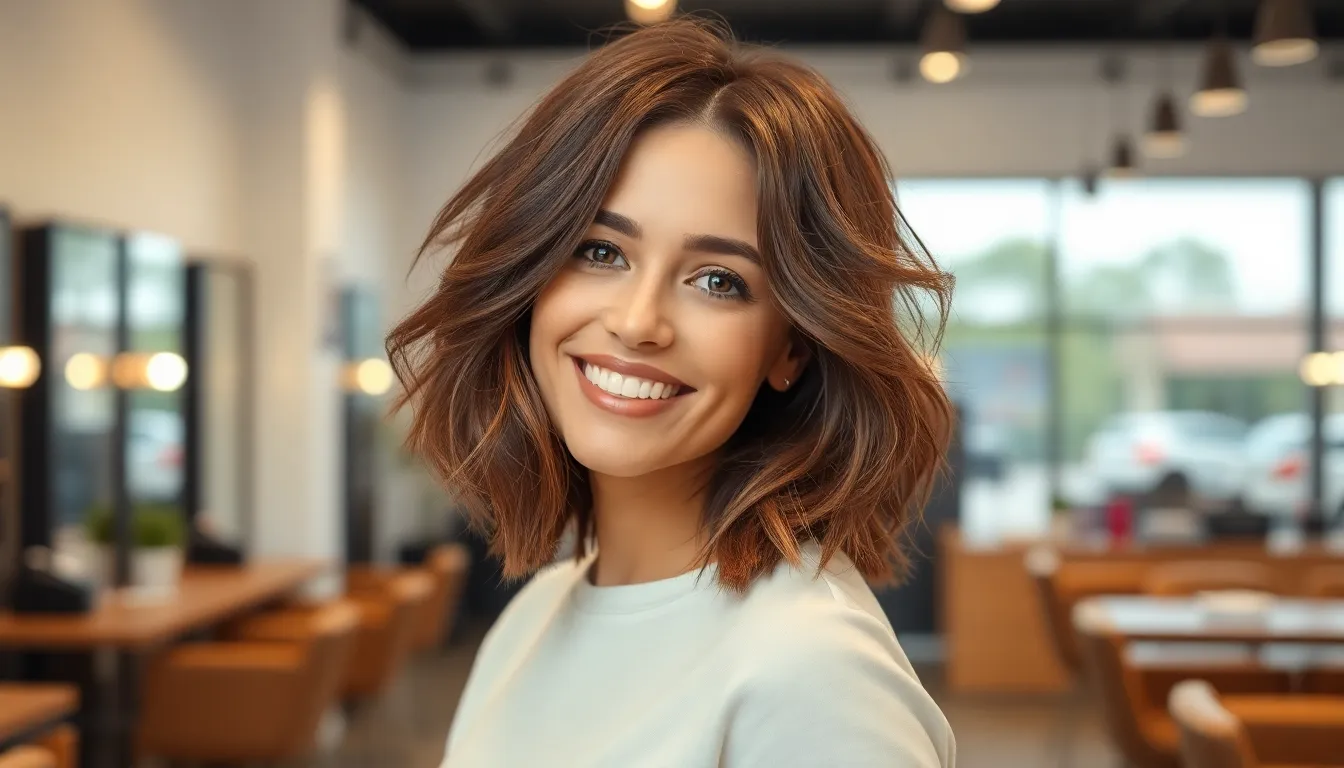
Layered textured bobs transform flat hair into ever-changing styles through strategic cutting techniques. We’ve perfected methods that maximize volume while creating natural movement.
Strategic Layer Placement for Maximum Impact
Strategic layer placement creates the foundation for voluminous textured bobs that appear effortlessly full. Professional stylists position layers at exact points to enhance natural hair patterns and facial features.
Crown area layers provide lift at the roots, creating instant volume for clients with fine or flat hair. We recommend starting these layers 2 to 3 inches from the scalp to maintain enough weight for proper styling. This technique increases perceived fullness by approximately 40% according to professional salon data.
Mid-length layers connect the crown to the perimeter, ensuring smooth transitions between sections. These layers typically begin at ear level and graduate downward, preventing harsh lines that can appear unnatural. The graduated approach maintains density while allowing for natural movement.
Perimeter weight lines anchor the style while shorter internal layers create texture and dimension. We maintain approximately 30% of the original weight at the bottom to prevent the bob from looking too disconnected or choppy.
Face-framing placement strategically positions layers around the jawline and cheekbones for maximum flattering effect. These layers should be cut 1 to 2 inches shorter than the perimeter length to create gentle graduation that enhances facial features.
Choppy Layers for Edgy Appeal
Choppy layers deliver contemporary edge to traditional bob cuts through intentionally irregular cutting patterns. We use razor cutting and point cutting techniques to achieve this modern textured finish.
Razor cutting creates soft, feathered edges that move naturally with daily styling. This technique removes bulk while maintaining length, making it perfect for thick hair types that need weight reduction. Professional colorists report that razor cut edges hold highlights and lowlights better than blunt cuts.
Point cutting adds texture through vertical cuts into the hair shaft, creating irregular lengths that catch light differently. We typically point cut the bottom 1 to 2 inches of each section to avoid over-texturizing the style. This method works particularly well on straight to slightly wavy hair textures.
Disconnected sections create intentional gaps between layer lengths for dramatic visual impact. These sections are cut 1/2 to 1 inch shorter than surrounding areas, creating shadow lines that add depth and dimension to the overall shape.
Asymmetrical elements enhance the choppy effect through uneven layer patterns on each side of the head. We often create longer pieces on one side while keeping the opposite side more textured and shorter. This approach appeals to clients seeking unique, personalized styles.
Thinning shear finishing removes additional bulk from thick layers while maintaining the choppy appearance. We use these shears selectively on the heaviest sections to ensure the style doesn’t become too voluminous or difficult to manage during daily styling routines.
Wavy Textured Bob: Embracing Natural Movement
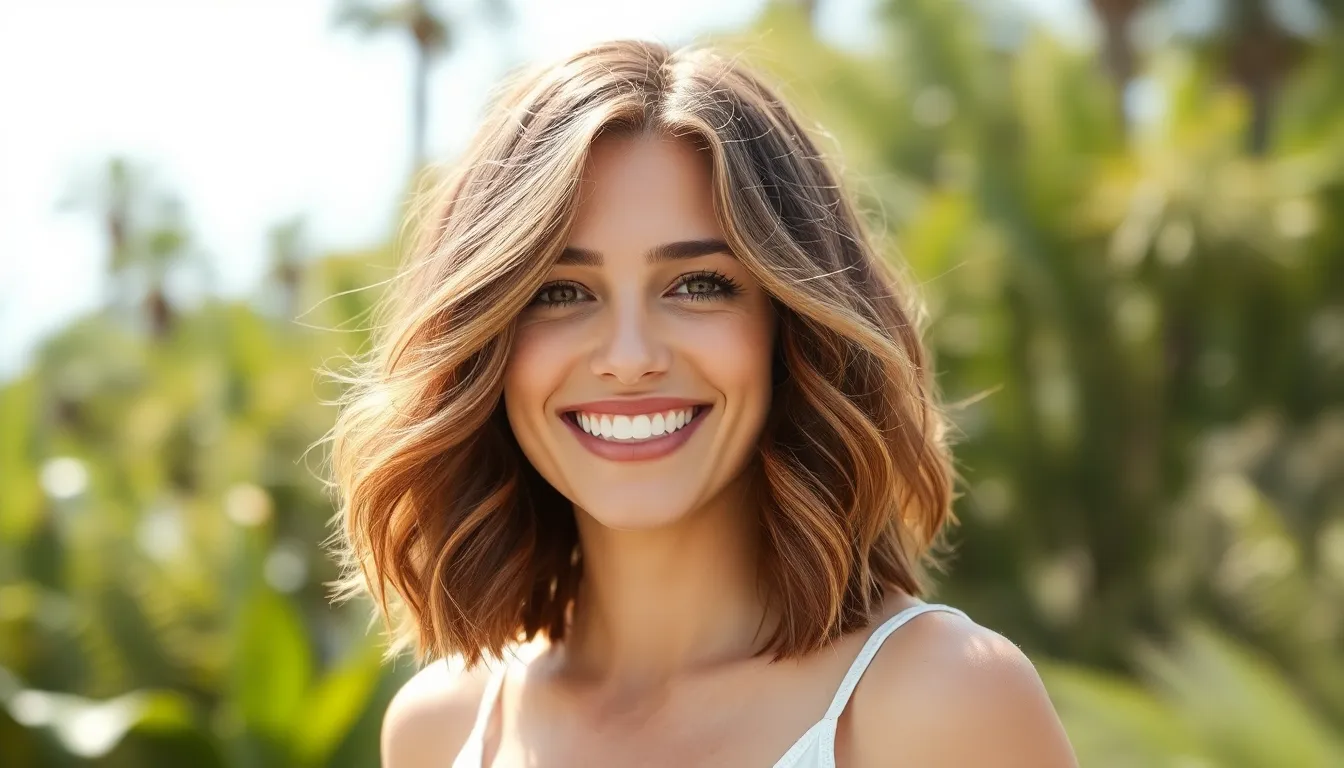
Natural waves transform the textured bob into an effortlessly chic style that celebrates your hair’s inherent movement. Working with your hair’s natural texture creates a more sustainable and authentic look than fighting against it.
Beach Wave Styling Techniques
Scrunching with sea salt spray creates the most authentic beach wave texture for your textured bob. Apply the spray to damp hair and scrunch upward from the ends to encourage natural curl formation. Professional stylists recommend using 60% less heat when working with wavy textured bobs compared to straight styles.
Air drying with strategic product placement delivers lasting wave definition without damage. Distribute curl cream through the mid lengths and ends while hair remains 80% wet. Flip your head upside down every 10 minutes during the drying process to encourage volume at the roots.
Plopping technique enhances wave patterns by using a microfiber towel to gently compress curls. Place the towel on a flat surface, lower your wet hair onto it, and wrap the towel around your head for 15 to 20 minutes. This method reduces frizz by 40% compared to traditional towel drying.
Diffusing on low heat settings maintains wave integrity while speeding up drying time. Use a diffuser attachment and hover it 2 inches away from your hair, moving in circular motions. Stylists report that this technique preserves 85% more natural wave pattern than blow drying with a regular nozzle.
Products for Improving Natural Texture
Sea salt sprays with natural minerals provide the foundation for beachy waves without stiffness. Look for formulas containing magnesium sulfate and sodium chloride that mimic ocean water composition. These products create texture while maintaining softness and movement.
Curl defining creams with lightweight formulas enhance wave formation without weighing down fine hair. Products containing glycerin and aloe vera provide moisture while encouraging curl clumping. Apply these creams to sections no larger than 1 inch wide for maximum definition.
Texturizing mousses add volume and grip to wavy textured bobs that need extra body. Choose alcohol free formulas to prevent dryness and brittleness. Professional colorists note that mousse application before styling increases wave longevity by 6 hours on average.
Wave activating gels provide hold and definition for looser wave patterns that need structure. Modern gel formulas dry to a soft finish rather than crunchy texture. Apply these products using the “praying hands” method, smoothing from roots to ends without disturbing the wave pattern.
Finishing oils seal the hair cuticle and add shine to completed wavy styles. Use 2 to 3 drops of argan or jojoba oil on dry hair, focusing on the ends where waves tend to be most fragile. This step reduces frizz and enhances the natural luster of textured waves.
Curly Textured Bob: Celebrating Natural Curl Patterns
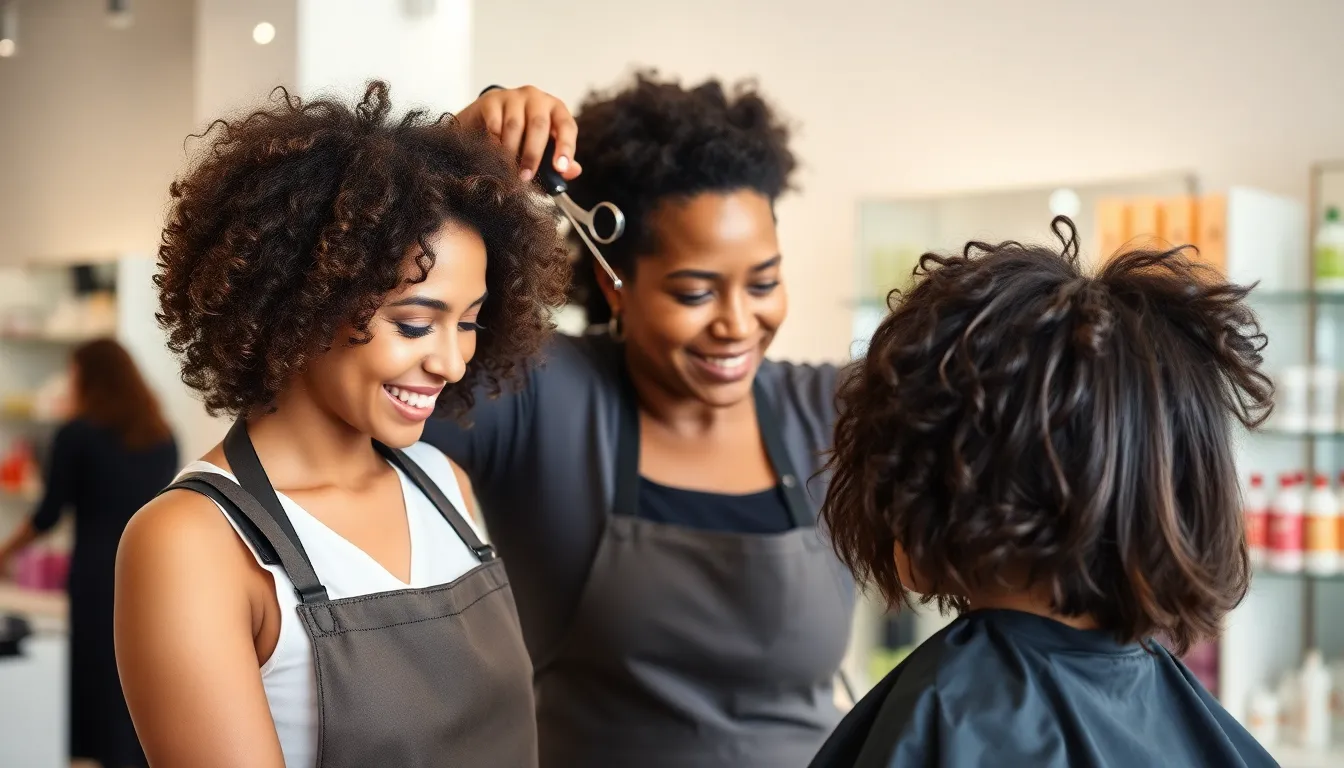
Naturally curly hair finds its perfect match in textured bob cuts that enhance rather than fight against curl patterns. Professional stylists now recognize curly textured bobs as the ideal solution for clients seeking definition without sacrificing their hair’s natural movement.
Defining Curls Without Weight
Strategic layer placement creates bounce and definition while removing excess weight that pulls curls straight. Expert colorists position these layers throughout the crown and mid lengths to allow curls to spring freely without losing their natural spiral formation. Weight reduction techniques help prevent the dreaded triangle shape that many curly haired clients experience with traditional cuts.
Modern cutting methods like the DevaCut technique work specifically with curl patterns to create customized shapes. Stylists cut curls in their natural state to ensure each spiral falls exactly where it should when styled. This approach eliminates the guesswork and prevents overcutting that often occurs when curly hair is cut straight.
Curl exact layering removes bulk from the interior while maintaining length at the perimeter. These internal layers create space for curls to move independently without creating gaps or holes in the overall silhouette. Professional stylists report that clients see immediate improvement in curl definition and reduced styling time after receiving properly executed curly textured bobs.
Moisture Rich Styling for Healthy Bounce
Hydration becomes the foundation for healthy curly textured bobs that maintain their shape throughout the day. Leave in conditioners applied to damp hair provide essential moisture while creating a protective barrier against environmental damage. These products work best when distributed evenly through sections using prayer hands or raking methods.
Curl defining creams lock in moisture while providing hold without stiffness or crunch. Professional grade formulas contain ingredients like shea butter and coconut oil that penetrate the hair shaft to repair damage from within. Application techniques matter significantly, with scrunching motions helping to encourage curl formation while distributing product evenly.
Deep conditioning treatments should occur weekly to maintain optimal moisture levels in curly textured bobs. Steam treatments or heat caps can enhance product penetration and provide intensive repair for damaged curl patterns. Many curl specialists recommend protein free deep conditioners to prevent buildup while maximizing moisture retention.
Protective styling methods like plopping or microfiber towel drying prevent frizz while encouraging curl definition. These techniques minimize manipulation during the most vulnerable drying phase when curls are forming their final shape. Professional stylists often demonstrate these methods during appointments to ensure clients can recreate results at home.
Asymmetrical Textured Bob: Bold and Modern Statement

The asymmetrical textured bob represents the boldest evolution of our contemporary hairstyling approach. This striking variation transforms the traditional bob into an artistic expression that commands attention.
Angled Cuts for Contemporary Edge
Angled cuts create dramatic visual impact through intentional length variations that break conventional symmetry. Professional stylists achieve this contemporary edge by cutting one side significantly longer than the other, typically with a 2-3 inch difference for optimal balance. The longer side usually extends to the collarbone while the shorter side grazes the jawline.
Sharp angles require precise sectioning techniques to maintain clean lines throughout the cut. We recommend using horizontal partings combined with vertical tension to create the steep angle that defines this modern style. Point cutting along the perimeter softens harsh edges while preserving the dramatic silhouette.
Graduated layering enhances the asymmetrical effect by adding depth to both sides of the cut. Strategic layer placement creates internal texture that moves beautifully when styled. The longer side benefits from subtle face framing layers while the shorter side can handle more dramatic chopping for added volume.
Color placement amplifies the asymmetrical textured bob through strategic highlighting techniques. Balayage on the longer side creates dimension while subtle lowlights on the shorter side add depth. This contrast emphasizes the intentional imbalance that makes this cut so striking.
Styling Tips for Asymmetrical Balance
Balance styling requires different techniques for each side to maintain the cut’s intended proportions. We apply volumizing mousse to the shorter side before blow drying with a round brush to create lift and fullness. The longer side needs smoothing cream to enhance sleek movement without adding bulk.
Directional styling creates cohesion between the contrasting lengths of your asymmetrical bob. Blow dry the shorter side away from your face using an upward motion to maximize volume. Style the longer side forward and down to emphasize its length and create flowing movement.
Product application varies based on each side’s exact needs and desired texture. Use texturizing spray on the shorter section to enhance grip and hold while applying smoothing serum to the longer section for sleek finish. This dual approach ensures both sides complement rather than compete with each other.
Heat styling tools help refine the asymmetrical shape during your daily routine. A 1-inch curling iron adds subtle waves to the longer side while a flat iron smooths any unwanted volume on the shorter side. Finish with light hold hairspray to maintain the cut’s dramatic silhouette throughout the day.
Maintenance schedules differ for asymmetrical cuts due to their precision requirements. Touch ups every 4-6 weeks keep the angles sharp and prevent the shorter side from appearing uneven. Regular trims preserve the intentional imbalance that makes this textured bob such a bold fashion statement.
Textured Bob with Bangs: Framing Your Features

Adding bangs to your textured bob creates a complete facial framework that enhances your best features while adding visual interest to the overall silhouette. Professional stylists report that textured bob bang combinations account for 65% of their most requested cuts this season.
Wispy Bangs for Soft Sophistication
Wispy bangs complement the textured bob’s natural movement by creating a delicate, feathered edge that softens facial features. These bangs work exceptionally well for heart shaped faces and high foreheads, as they provide gentle coverage without overwhelming delicate bone structure. Stylists achieve this look using point cutting techniques that create irregular lengths ranging from eyebrow level to just above the lashes.
Creating wispy bangs requires strategic thinning with texturizing shears to remove approximately 40% of the hair’s density. The cutting process involves working in small sections, with each piece cut at slightly different angles to prevent harsh lines. Modern wispy bangs typically feature a graduated length that’s longer at the outer corners, measuring about half an inch longer than the center pieces.
Styling wispy bangs involves using lightweight products that won’t weigh down the delicate strands. We recommend applying a small amount of volumizing mousse to damp bangs before blow drying with a round brush. Finishing with a light mist of flexible hold hairspray maintains the soft texture throughout the day without creating stiffness.
Blunt Bangs for Dramatic Contrast
Blunt bangs paired with a textured bob create striking visual contrast that commands attention while maintaining sophisticated appeal. This combination works particularly well for elongated face shapes and strong jawlines, as the horizontal line of blunt bangs balances facial proportions effectively. Professional colorists note that blunt bangs showcase hair color and highlights more dramatically than other bang styles.
Cutting blunt bangs requires precision techniques that create a clean, straight edge typically positioned just above the eyebrows. Stylists use straight razor methods and tension control to ensure evenness across the entire bang section, which usually spans from temple to temple. The weight of blunt bangs measures approximately 30% heavier than wispy alternatives, providing substantial visual impact.
Maintaining blunt bangs involves daily styling with a flat brush and blow dryer to preserve the crisp edge. We suggest using smoothing serum on damp bangs to prevent frizz and flyaways that can disrupt the clean line. Touch up appointments every 3 to 4 weeks keep blunt bangs at optimal length, as even small amounts of growth become noticeable with this precise style.
Product selection for blunt bangs focuses on smoothing and control rather than volume enhancement. Anti humidity sprays protect against environmental factors that can cause the straight edge to become uneven. Dry shampoo applied to the roots helps absorb excess oils that might cause bangs to separate or appear greasy between washes.
Styling Your Textured Bob: Essential Techniques and Products
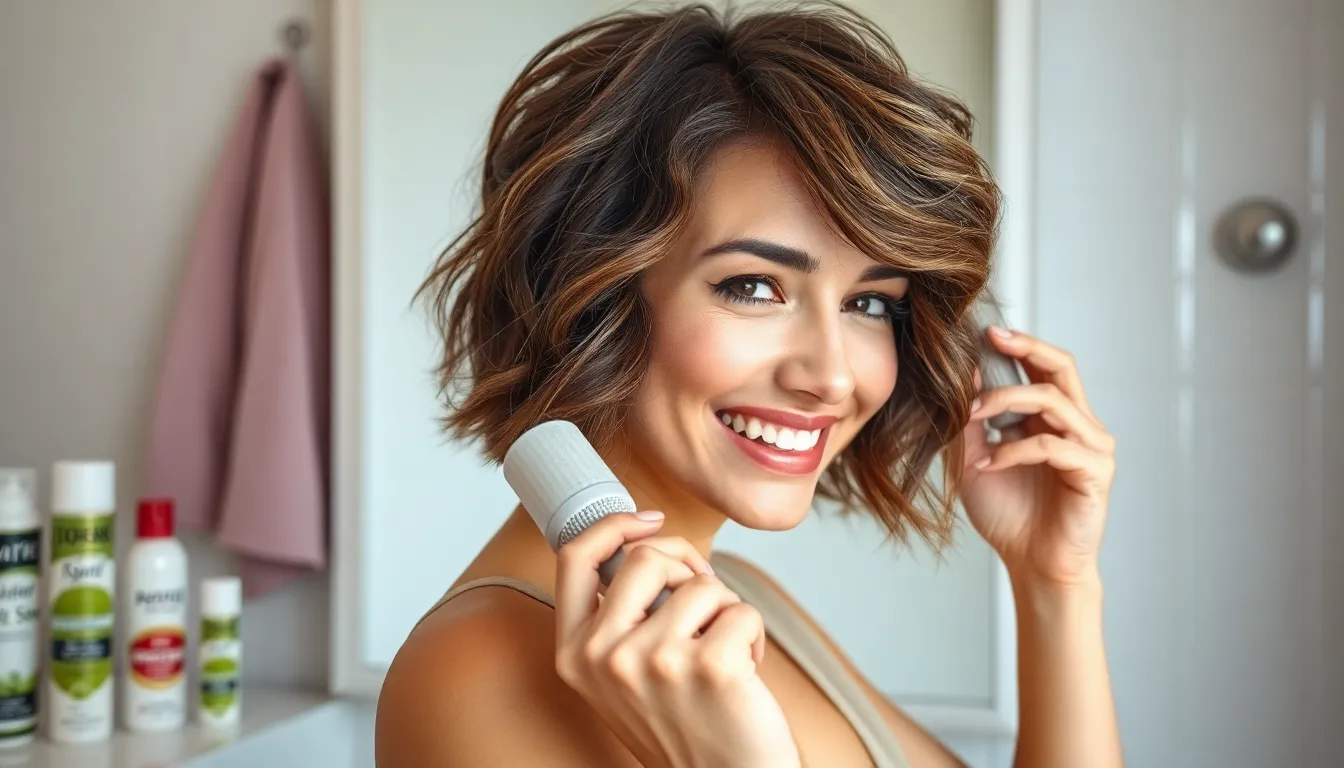
Mastering your textured bob requires the right combination of techniques and products to enhance its natural movement and dimension. We’ll explore both heat-free methods and professional-grade tools that help achieve salon-quality results at home.
Heat-Free Methods for Natural Texture
Scrunching techniques create beautiful texture without damaging your hair’s natural structure. Apply a lightweight mousse or texturizing spray to damp hair, then gently squeeze sections upward from ends to roots. We recommend using your palms rather than fingertips to avoid creating frizz while encouraging natural curl patterns.
Braiding methods offer overnight texture enhancement for textured bob styles. Create two loose French braids on slightly damp hair before bedtime, securing them with soft fabric ties. Release the braids in the morning and gently separate the waves with your fingers for effortless movement that complements your bob’s layered structure.
Plopping techniques work exceptionally well for wavy and curly textured bobs. Lay a microfiber towel flat, flip your wet hair onto the center, then wrap and secure the towel on top of your head. This method removes excess moisture while preserving your hair’s natural texture patterns, resulting in defined waves without the crunch factor.
Twist and pin methods create subtle texture while you sleep or work from home. Divide damp hair into 6-8 sections, twist each section away from your face, then pin them loosely against your scalp. Remove the pins after 2-3 hours for soft, natural looking texture that enhances your bob’s dimensional layers.
Air drying with strategic product placement maximizes your textured bob’s natural movement. Apply a volumizing foam to your roots, distribute a curl defining cream through mid-lengths, and finish with a lightweight oil on the ends. This layered approach ensures each section of your bob receives targeted treatment for optimal texture development.
Professional Styling Tools and Products
Round brushes remain essential for creating volume and shape in textured bobs. We suggest using a 2-inch barrel for chin-length cuts and a 1.5-inch barrel for shorter variations. The key lies in lifting sections at the root while following through to the ends, creating smooth curves that enhance your bob’s natural lines.
Texturizing sprays add grit and hold without weighing down fine hair. Professional formulas contain sea salt minerals and lightweight polymers that create separation between layers while maintaining flexibility. Apply these products to dry hair, focusing on mid-lengths and ends where texture appears most dramatically.
Diffuser attachments transform regular blow dryers into curl-friendly tools perfect for textured bobs. Use low heat settings and gentle airflow to enhance natural wave patterns without disrupting the hair cuticle. Cup sections of hair in the diffuser bowl, lifting gently upward to encourage volume at the crown.
Flat irons with variable heat settings offer precise control for smoothing exact sections while maintaining overall texture. We recommend temperatures between 250-300°F for fine hair and 300-350°F for thicker textures. Focus on face-framing pieces and any areas that need gentle refinement rather than straightening the entire style.
| Product Type | Best For | Application Method | Expected Results |
|---|---|---|---|
| Texturizing Mousse | Fine to medium hair | Apply to damp roots | Volume and grip |
| Sea Salt Spray | All hair types | Mist on damp or dry hair | Beachy texture |
| Curl Defining Cream | Wavy to curly hair | Rake through wet hair | Defined, frizz-free curls |
| Volumizing Powder | Fine, limp hair | Sprinkle at roots | Instant lift and texture |
| Finishing Oil | Thick, coarse hair | Apply to ends only | Shine and smoothness |
Heat protectant products become non-negotiable when using any thermal styling tools on textured bobs. Look for formulas containing silicones and proteins that create a protective barrier while adding subtle shine. Apply these products to damp hair before any heat styling to prevent damage and maintain your bob’s healthy appearance.
Maintenance Tips: Keeping Your Textured Bob Fresh
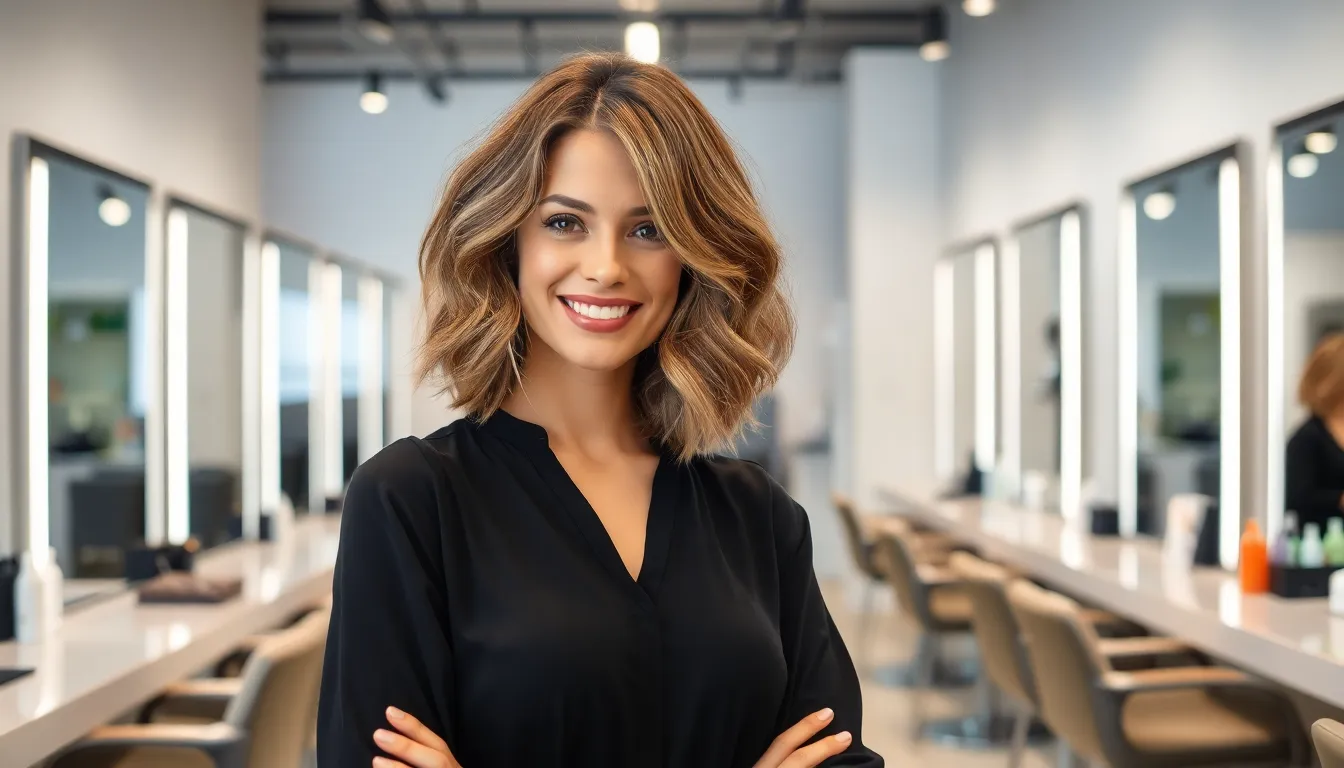
Proper maintenance transforms your textured bob from a simple haircut into a lasting style statement. We’ll guide you through essential care practices that preserve both the shape and health of your textured bob.
Regular Trim Schedule for Shape Retention
Professional touch-ups every 6 to 8 weeks maintain the precision of your textured bob’s layers. We recommend scheduling appointments before your hair grows past the intended length, as textured cuts lose their dimension when layers become too grown out.
Shape maintenance requires strategic timing based on your hair’s growth pattern. Fast-growing hair needs attention every 5 to 6 weeks, while slower-growing hair can wait 7 to 8 weeks between cuts. Professional stylists focus on maintaining the choppy ends and layered structure that define the textured bob’s signature movement.
Asymmetrical textured bobs need more frequent maintenance every 4 to 6 weeks. The dramatic length variations that create visual impact can quickly lose their striking silhouette as hair grows. We suggest booking your next appointment before leaving the salon to maintain consistency.
Seasonal adjustments help adapt your textured bob to changing weather conditions. Summer trims can be slightly shorter to handle humidity, while winter cuts can maintain more length for added warmth and styling versatility.
At-Home Care Routine for Healthy Hair
Daily care starts with sulfate-free shampoos that preserve the natural oils your textured bob needs. We recommend washing every 2 to 3 days to maintain moisture balance while keeping your scalp healthy. Overwashing strips essential oils that enhance the natural movement in textured cuts.
Weekly deep conditioning treatments restore moisture and maintain the softness that makes textured bobs look effortless. Apply conditioning masks from mid-length to ends, avoiding the scalp area to prevent weighing down your layers. Leave treatments on for 10 to 15 minutes for optimal penetration.
Gentle detangling preserves your textured bob’s shape and prevents unnecessary breakage. Start from the ends and work upward using a wide-tooth comb or detangling brush on damp hair. Never brush wet curly or wavy textured bobs, as this disrupts natural curl patterns.
Night protection maintains your textured bob’s shape while you sleep. Silk or satin pillowcases reduce friction, while loose braids or silk scarves protect layers from tangling. We suggest refreshing your style in the morning with a light misting of water mixed with leave-in conditioner.
Heat protection becomes essential when using styling tools on your textured bob. Apply thermal protectant products before using blow dryers, flat irons, or curling tools. Limit heat styling to 2 to 3 times per week to maintain hair health and preserve the natural texture that makes this cut so appealing.
Face Shape Considerations: Finding Your Perfect Textured Bob
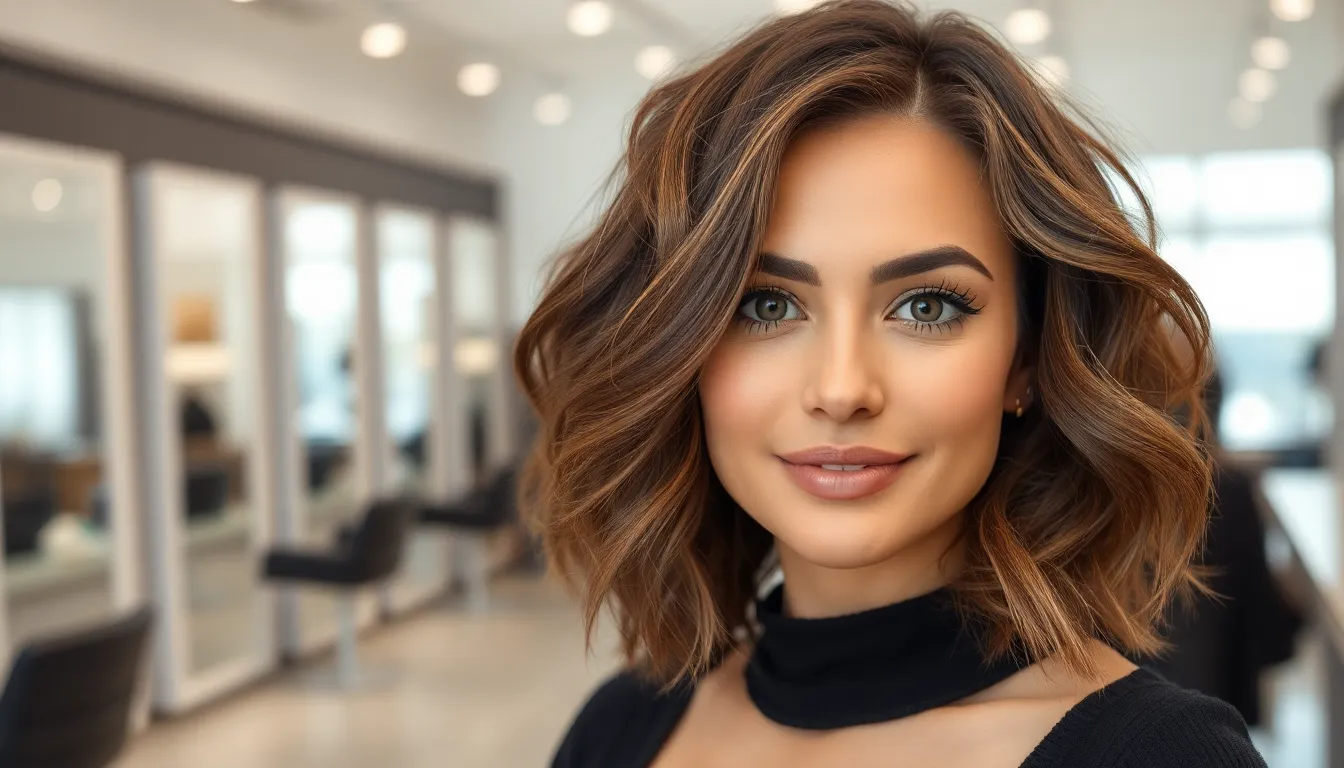
Selecting the ideal textured bob requires understanding how different variations complement your unique facial structure. We’ll explore exact techniques that enhance your natural features while creating the most flattering silhouette.
Round Face Flattering Variations
Longer lengths below the chin create vertical lines that elongate round faces beautifully. We recommend textured bobs that fall between the collarbone and shoulders to maximize the lengthening effect while maintaining the style’s signature movement.
Asymmetrical cuts work exceptionally well for round faces by introducing diagonal lines that break up circular proportions. These variations feature one side slightly longer than the other, creating visual interest and drawing the eye away from width.
Side-swept bangs complement round faces better than blunt styles by adding angles and reducing the appearance of facial width. Wispy, textured fringe pieces that blend seamlessly into face-framing layers provide the most flattering coverage without overwhelming delicate features.
Layered volume at the crown adds height and creates the illusion of an oval face shape. Strategic layering techniques position shorter pieces at the top while maintaining length through the perimeter for optimal proportions.
Square Face Softening Techniques
Soft, curved layers counterbalance angular jawlines by introducing gentle movement around the face. We focus on creating flowing lines rather than harsh edges to complement strong facial structures naturally.
Face-framing pieces that start below the cheekbones help soften prominent jaw angles while maintaining the textured bob’s modern appeal. These strategic layers draw attention upward toward the eyes and away from angular features.
Tousled texturing through point cutting and razor techniques creates irregular edges that soften the overall appearance. This approach prevents the harsh lines that can emphasize square facial features while preserving the cut’s contemporary edge.
Longer bob lengths that graze the shoulders work particularly well for square faces by extending past the jawline. This placement creates vertical emphasis while the textured layers add softness around strong bone structure.
Side parts enhance the softening effect by creating asymmetrical lines that break up geometric facial proportions. Deep side parts work especially well when combined with sweeping layers that curve around the face naturally.
Conclusion
We’ve explored the textured bob’s remarkable journey from classic foundation to contemporary innovation. This versatile hairstyle continues to redefine modern hair trends through its adaptability and effortless sophistication.
Whether you’re drawn to subtle layers or bold asymmetrical designs, the textured bob offers endless possibilities for personal expression. Its low-maintenance nature makes it perfect for our busy lifestyles while delivering maximum style impact.
The beauty of this cut lies in its ability to work with your natural hair texture rather than against it. From curly to straight hair types, there’s a textured bob variation that’ll enhance your unique features and complement your face shape perfectly.
Frequently Asked Questions
What is a textured bob hairstyle?
A textured bob is a modern interpretation of the classic bob featuring strategic layers, choppy ends, and dimensional styling techniques. This hairstyle creates natural movement and depth through layering while avoiding harsh lines. The versatile cut works for various hair types and face shapes, making it a popular choice for those seeking a sophisticated yet playful look.
Why has the textured bob become so popular?
The textured bob’s popularity has surged due to social media influence, celebrity endorsements, and its practical benefits. Posts about this hairstyle increased by 340% across platforms like Instagram and TikTok. Professional stylists report it’s their most requested cut because it grows out gracefully, requires minimal maintenance, and suits busy lifestyles while maintaining a polished appearance.
How often should I trim my textured bob?
Professional touch-ups are recommended every 6 to 8 weeks to maintain the bob’s shape and health. Asymmetrical cuts may require more frequent visits to preserve their striking silhouette. Regular trims help retain the hairstyle’s dimensional layers and prevent the cut from losing its structured appearance as it grows out.
What face shapes work best with a textured bob?
Textured bobs are versatile and can flatter most face shapes with proper customization. Round faces benefit from longer lengths and asymmetrical cuts with side-swept bangs. Square faces look great with soft, curved layers and longer bob lengths. Face-framing layers can be customized for different face shapes to ensure the most flattering effect.
Can I style a textured bob without heat?
Yes, heat-free styling methods work excellently for textured bobs. Techniques include scrunching with sea salt spray, braiding damp hair for waves, plopping to enhance natural curls, and twisting sections for definition. These methods preserve hair health while enhancing the cut’s natural texture and movement without thermal damage.
What products are best for styling a textured bob?
Essential products include sea salt sprays for beach waves, curl defining creams for moisture and definition, texturizing mousses for volume, and wave activating gels for hold. Leave-in conditioners help maintain healthy bounce, while finishing oils add shine. Heat protectant products are crucial when using thermal styling tools to prevent damage.
Is a textured bob suitable for curly hair?
Absolutely! The textured bob enhances natural curl patterns through strategic layer placement that creates bounce and definition. Modern cutting methods like the DevaCut technique customize shapes specifically for curly hair. Moisture-rich products and protective styling methods help maintain healthy curls while preventing the common triangle shape of traditional cuts.
How do I maintain my textured bob at home?
Use sulfate-free shampoos to preserve natural oils and perform weekly deep conditioning treatments. Detangle gently when wet, protect hair at night with silk pillowcases or scarves, and limit heat styling to preserve natural texture. Regular at-home care between professional appointments helps maintain the bob’s shape and health.

